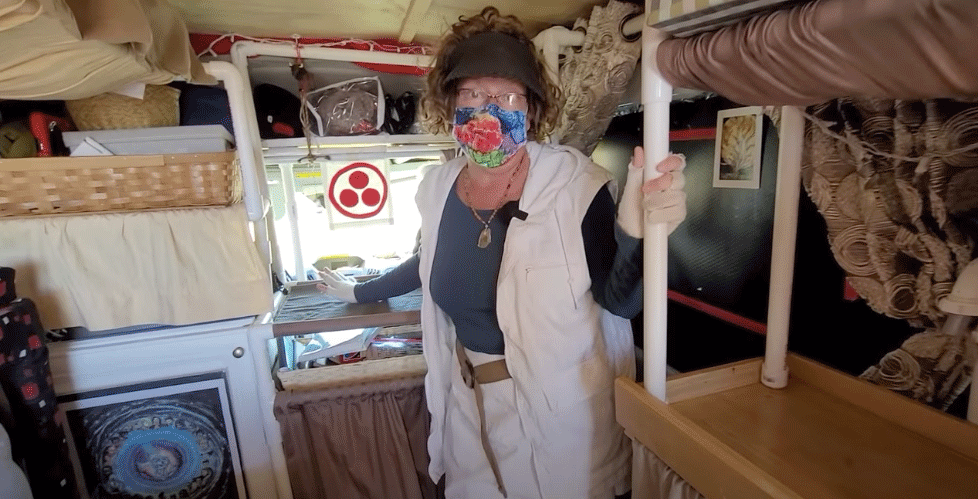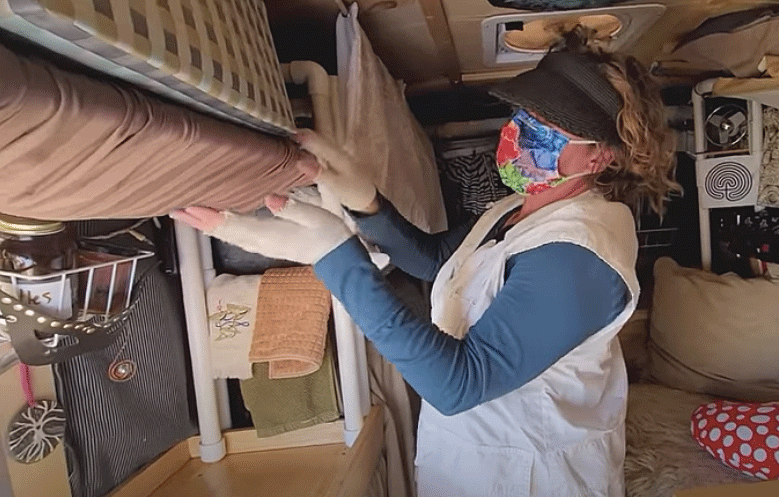
Babz is one of the true veterans of nomadic living. She has lived in various vehicles and RVs for 26 years. She is currently in a Ford Transit that features some interesting build-out solutions.
“I’ve used a lot of PVC pipe. I found that for someone with limited carpentry skills it was an excellent lightweight solution, and it’s very easy to work with. It’s kind of fun, like being a kid and cutting and putting them together.

“It’s just the stuff you buy at Lowe’s. There’s PVC you can buy that’s made for furniture, and it doesn’t have the advertising on it, so I’ve turned it all so you can’t see it. But yeah, I built this whole cabinet here over the cooler and this one for maybe thirty dollars. This shelf is PVC that’s suspended from the ceiling.
“I do have to say, not a lot of these fittings you can’t get them at Lowe’s. You have to get them on either amazon or go right to the company to get them. There if you look at some of them this is a four-way so that’s like a three dollar piece.”
Notice how Babz has wrapped fabric (thrift store sheets) between the pipes to create shelves.

How are you cutting them? With a hand saw?
“No, I have a PVC pipe cutter. I’ve actually been through three of them, though.”
“I would recommend if you’re working with PVC is that you put it on something that can handle the weight. These pieces were all from the upcycle stores.”
WHAT’S THE DIFFERENCE BETWEEN STANDARD AND FURNITURE-GRADE PVC?
Standard PVC (Schedule 40 or 80) is designed to be used inside buildings, often hidden between walls, away from sunlight. Exposure to the elements degrades its strength. On the other hand, furniture-grade PVC is glossy, doesn’t have manufacturers data printed on the outside, and its surface (which is available in several colors) is much more resistant to ultraviolet and impact damage. Furniture-grade PVC also offered a greater selection of fittings. Whereas standard PVC fittings are limited to mostly couplers, elbows, T’s, Y’s and caps, furniture-grade PVC fittings include 3-way, 4-way, 5-way, adjustable angles, mounting caps and more.

Standard PVC is lower priced than furniture-grade. You can enhance its resistance to sunlight and other damage by painting it with latex or acrylic paint that’s chemically compatible with PVC. That would also cover the printing. Since the interior of your rig is away from the elements, you might be satisfied simply sanding off the printing or, as Babz has done, just turn it away from you.
HOW CAN YOU HOLD IT TOGETHER?
Regular 2-part PVC adhesive will leave a purple stain at the joints, which isn’t a problem if you’re going to paint the assembly or if appearance isn’t important to you. But since you’re not going to be pumping water through your furniture (I presume) you don’t need a watertight connection. (But, hmmm, water storage in your furniture…) Other adhesives should be able to hold things sufficiently. Or self-tapping screws. Babz has found that the snugness of the fittings, plus gravity, have been enough for her various constructions.
IT LOOKS COMPLICATED
Projects like this require a little understanding of how to build for function and strength, and the ability to envision how the pieces go together, but that’s true no matter what you build with. In the case of PVC it’s a matter of thinking, “Okay, I need to make this shape, this size, and connect it to this other shape. What kind of fittings will make that happen?” Piece by piece, plan it out. Take measurements, make sketches. Think on it. Sleep on it. Let your subconscious figure things out while you do something else. Test fit everything. Have enough materials to allow for mistakes. And learn from those mistakes. You can do it.

Thanks for the good idea. Where are the companies that makes the fittings.
Follow the “made for furniture” link above.
Great idea. My ex once built a 2-story parakeet cage of PVC. He put it on wheels so we could roll it in and out of the enclosed patio easily to outside. “Jimmy” loved being able to chatter to the wild birds next to the pool 🙂
Excellent!
Hmmm, I’m trying to build a plant shelf/ dish drying rack shelf above my sink. PVC might be the answer : ). Also, thinking of a movable catio after the information shared for the bird cage.
Thank you!
I like your thought of possibly storing water inside. Another good use would be outside water heating. Of course you’d have to seal and paint all but paint it black to heat water better?
I’d like hints to make a bed frame for my little Runaway camping trailer. I’m 4’11” and weigh about 150, so want to keep it 62-66″ long and 17-20″ wide (I don’t move much and I’m a back sleeper) and 12-18″ tall (short legs for sitting on it). And what type of board to set on top to make the bed surface?
Oh, and I want it to be able to double as a sofa during the day.
One thing not included in this article or the video is that PVC can be painted or stained. I’ve built PVC furniture from sched 40 and sched 80 pipe- thicker and made for high pressure. Staining it results in very pretty builds and painting (use the correct paint- I like Krylon). It can be glued together or not (making the item very portable.)
From the ninth paragraph:
“Standard PVC is lower priced than furniture-grade. You can enhance its resistance to sunlight and other damage by painting it with latex or acrylic paint that’s chemically compatible with PVC.”
Also, from the How Do You Hold It Together section:
“…which isn’t a problem if you’re going to paint the assembly…”
clear primer not purple. get it at plumbing supply houses or online. bob the plumber. raz
Thanks for the tip!
PVC WARNING!!! I do natural health research and I want you and all of the subscribers and Bob that PVC pipe is one of the MOST TOXIC PLASTICS there is. Don’t take my word for it, look it up and do your own research! These are not only are cancer causing plastics but other toxic items, also. I myself have been contaminated by PBB and Polychlorinated Biphenyl’s back in the 1970’s and I’d just had a new baby and my pediatrician requested I be tested for these contaminates. When they either accidentally or on purpose mixed fire retardant chemicals in with cattle feed in St. Louis, Michigan. It was a horrible thing that killed and deformed thousands of cattle. That is what got me started on researching everything. From medical (I worked in the medical field for over 35 years) to pesticides and foods. Please warn everyone that it is NOT safe to use or handle.
Excellent warning, but sadly many don’t care about toxins and continue to drink, eat and cook with plastic. People wonder why the cancer numbers are through the roof. We have not been good stewards of our planet and sadly everyone pays the price.